T H E
M A R I N
L A W Y E R






T H E
M A R I N
L A W Y E R





Lead Editor: Elisha J. Yang
Guest Editors: Emily Harrington & Lucie C. Hollingsworth
Creative Director: Aariel Nigam
2025 Officers
President: Kristine Fowler Cirby
President-Elect: Thomas M. McInerney
Treasurer: Neusha N Ghaedi
Secretary: Robyn B Christo
Past President: Scott Buell
5 Year Past President: Matt White
Board of Directors
2025
Elisha J Yang
Lucie C Hollingsworth
Morgan H Daly
Nestor Schnasse
Shanti Eagle
2026
Christine O’Hanlon
Ingrid L Carbone
Marisa R. Chaves
Marrianne S. Taleghani
Roni D. Pomerantz
2027
Adrea S Tencer
Emily B Harrington
Paul Burglin
Sarah B. Anker
R. Wesley Pratt
Executive Director
Julie Cervetto
Membership & Events Manager
Denise Belli
Client Relations Chair
David M Zeff





The Marin Lawyer is published by The Marin County Bar Association 101 Lucas Valley Road, Suite 326 San Rafael, CA 94903 (415) 499-1314 info@marinbar org marinbar org


5 | Editor’s Introduction: Law, Community, and the Climate Crisis: A Collective Responsibility ELISHA J YANG
8 | 2025 President’s Message KRISTINE FOWLER CIRBY
11 | 2025 Board and Officers Installation Dinner and Legal Education Scholarship Fundraiser EMILY HARRINGTON
14 | County of Marin and California Coastal Commission Land Use Regulations are Critical for Adaptation to Sea Level Rise in Coastal Marin County
TERENCE CARROLL
18 | Non-Profit Spotlight: Canal Alliance CARLY FINKLE & DIANA BENITEZ
22 | Key 2025 CEQA Updates for Residential Developers: Extended Exemption and Streamlining Options NIRAN SOMASUNDARAM
26 | Get to Know a Judge: Hon Andrew Sweet LUCIE HOLLINGSWORTH
28 | EPA Issues New Underground Injection Control Permits for Carbon Capture Projects in California SEAN HERMAN, CHRISTOPHER POWELL & ALEXANDER AMES
31 | Rally Family Visitation Services: Back to InPerson Visits in Marin County KATHARINE BERG
33 | Get to Know a Board Member: Shanti Eagle MARIN COUNTY BAR ASSOCIATION

Elisha J. Yang, Senior Counsel - Hanson Bridgett LLP
Climate change is no longer a distant threat – it is a reality affecting our communities today. From rising sea levels and extreme weather to environmental injustices disproportionately impacting vulnerable populations, the legal system plays a critical role in shaping how we respond. But the law is not just for policymakers and corporations; it is a tool for communities, advocates, and individuals working to protect our shared future.
This issue of the Marin Lawyer focuses on the intersection of law, climate, and community action. Our contributors explore how lawyers, activists, and everyday citizens can use legal frameworks to hold polluters accountable, push for stronger regulations, and build resilience in their own neighborhoods. Terence Carroll of River Otter Ecology Project highlights the importance of creating coherent and equitable land use regulations in response to the sea level rise to protect our residents in West Marin. Niran Somasundaram of Hanson Bridgett LLP provides an update on how the California Legislature has explored the use of CEQA exemptions and streamlining through a number of new bills recently introduced to ease potential obstacles to much-needed housing development projects To continue the theme of streamlining processes for developers, Sean Herman, Christopher Powell, and Alexander Ames of
Hanson Bridgett LLP write about the first four Class VI injection wells (for carbon capture and sequestration projects) that the EPA has approved in California during the final days of the Biden Administration.
The climate crisis requires all of us – legal professionals, policymakers, and community members – to work together. By understanding the power of law in shaping environmental outcomes, we can ensure that justice, equity, and sustainability remain at the heart of climate action.
Local non-profit organizations, Rally Family Visitation Services and Canal Alliance are featured for their incredible work ensuring the safety of high-risk and low-income families and their children and advocacy work for Latino community members of Marin.

Want to get to know our MCBA leaders better? We are excited to share an interview with the honorable Judge Andrew Sweet and a spotlight article on Shanti Eagle, partner at Farella Braun + Martel LLP. Look for more spotlights on our leaders of the MCBA in future issues.
We hope this issue sparks dialogue, fosters collaboration, and empowers our readers to be part of the solution. As always, we welcome your thoughts and stories – because meaningful change happens when communities come together.
Thank you for reading, and as always, we welcome your thoughts and perspectives.

Elisha Yang’s tran covers a broad array o estate matters. She c food and beverage negotiations, including services agreement arrangements, and
agreements. In her real estate practice, El real estate owners and investors in disposition of commercial real property land, office buildings, and senior car represented both landlords and tenants and borrowers and lenders in real estate at project management and in implement flow management systems. A San Franc she is deeply involved in the community behalf of the Asian American Bar Associat


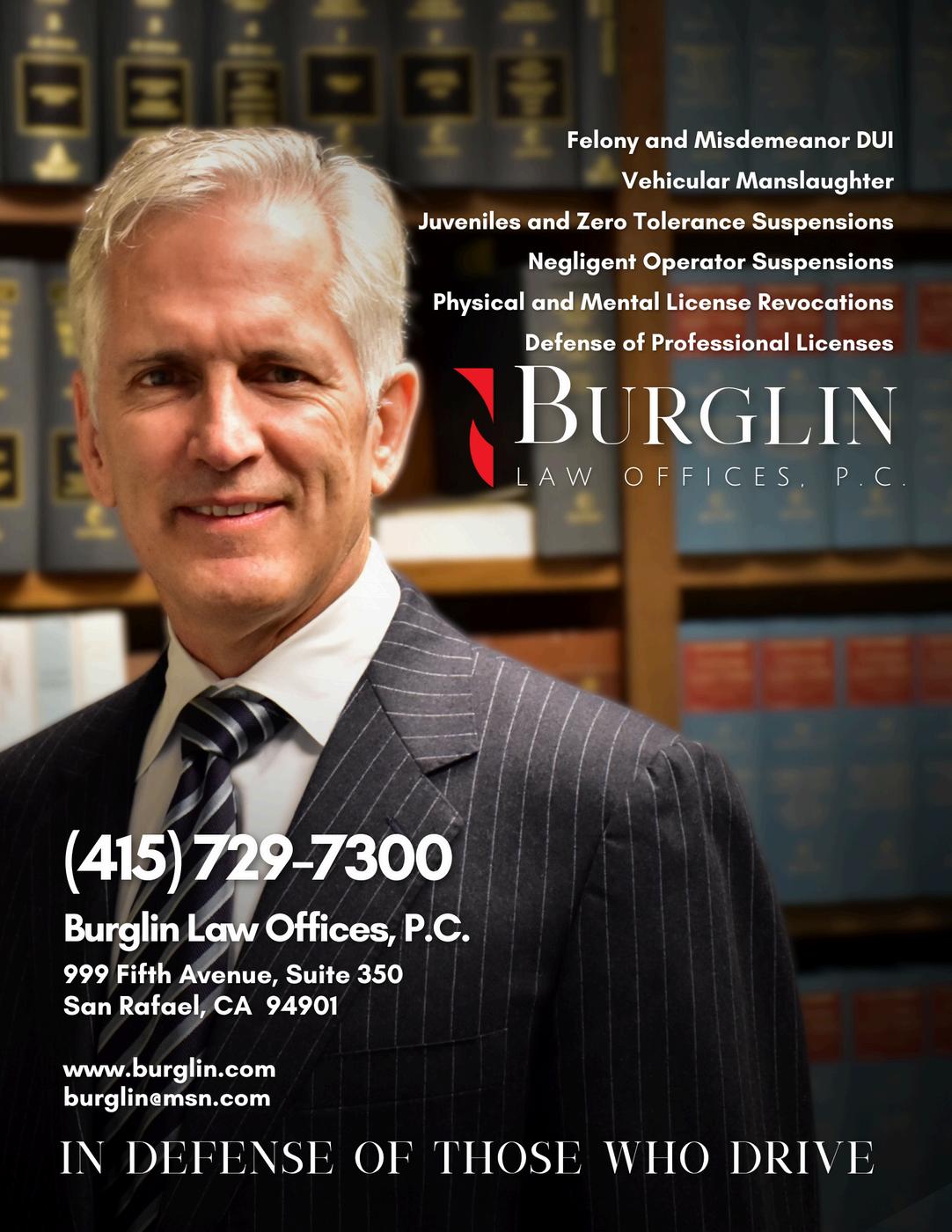


As we embark on this new chapter, I invite each of you to take part in shaping MCBA’s future. Let us honor our traditions while embracing fresh ideas that will allow us to grow and better serve our profession and community. Together, we can reaffirm our commitment to justice and use our collective knowledge, experience, and dedication to make a lasting impact.
I warmly invite every MCBA member to connect with me whether to share your thoughts on what you’d like to see from the MCBA, offer suggestions on how we can better support our members and the broader legal community, or simply to introduce yourself. Your insights and involvement are invaluable to me.
I look forward to seeing you at Burren House Irish Pub in San Rafael on Thursday, April 3, 2025, for our next Thirsty Thursday event. Let’s raise a glass to MCBA’s future, the relationships we will build, and the meaningful work we will accomplish together.

Kristine Fowler Cirby s a family law attorney with over 30 years of experience In 2019, she established her family law firm in Larkspur, handling all types of family law cases, including divorce, custody, domestic violence, and support matters Throughout her career, Kris has advocated for victims of domestic
violence, immigrants, and low-income families Kris was formerly the Executive Director at Family & Children’s Law Center She currently serves on the board of Community Violence Solutions Kris previously held leadership roles with the Marin County Law Library and Marin Women's Commission. In 2021, Kris received the Marin Trial Lawyers Association’s President’s Award


Emily Harrington, MCBA Director
On February 12th, 2025, MCBA was proud to host its annual Board and Officers Installation Dinner and Legal Education Scholarship Fundraiser at the Mill Valley Community Center. Despite a rainy and cold evening, 149 guests, elected officials, and judges gathered to witness the induction of MCBA’s 2025 officers and directors, and to celebrate the 2025 Legal Education Scholarship recipients.
Guests enjoyed “Thirty-Seven Wines” donated by Brayton Purcell LLP and enjoyed a delicious meal catered by Mangia Nosh Catering Company. The space was beautifully decorated by MCBA staff.
The program began with a warm welcome address by MCBA Executive Director Julie Cervetto, who then invited 2025 MCBA President Kristine Fowler Cirby to take the stage to award the President’s Plaque to 2024 MCBA President Scott Buell.
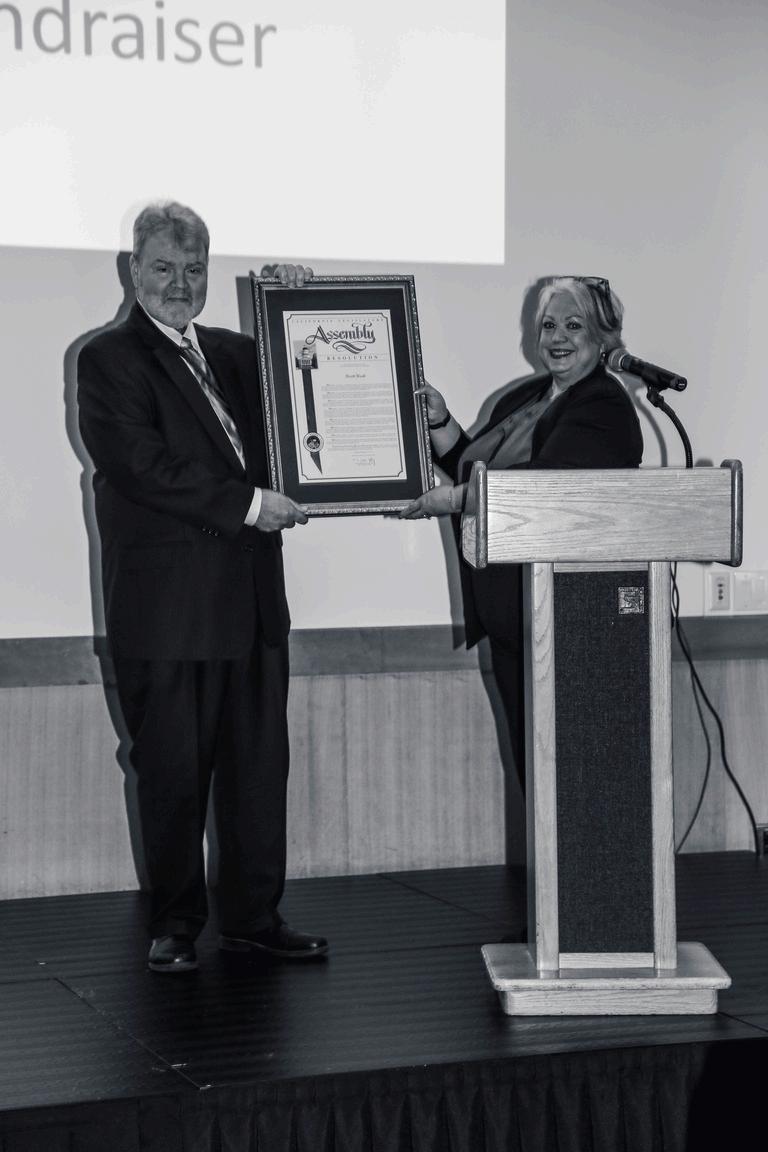
Judge Verna Adams (ret.) then administered the oath of office to incoming and returning directors and officers. This was followed by a separate swearing-in of the new 2025 MCBA President Kristine Fowler Cirby.
Ann Munene and Shanti Eagle continued the evening with a presentation and an introduction of the 2025 Legal Education Scholarship recipients: Natalie Dybeck, Maxwell Friend, Barbara Carmona, and Nicholas Saloma.
Following the presentation, David L. Winnett took the stage to begin the Fund-A-Need for the 2025 Legal Education Scholarship. Mr. Winnett’s affable personality and wit helped encourage guests to donate to this important cause. Guests pledged a generous total of $15,175.00 to support the MCBA scholarship fund and next year’s scholars. Thank you to our donors for your generous financial support to these amazing law students. Congratulations to MCBA’s 2025 Officers and Directors
Officers:
Kristine Fowler Cirby, President
Thomas M. McInerney, President-Elect
Neusha N. Ghaedi, Treasurer
Robyn B. Christo, Secretary
Scott Buell, Past President
Matt White, 5-Year Past President
Directors:
2025
Elisha J. Yang
Lucie C. Hollingsworth
Morgan H. Daly
Nestor Schnasse
Shanti Eagle
2026
Christine O’Hanlon
Ingrid L. Carbone
Marisa R Chaves
Marrianne S. Taleghani
Roni D. Pomerantz
2027
Adrea S. Tencer
Emily B. Harrington
Paul Burglin
Sarah B. Anker
R. Wesley Pratt
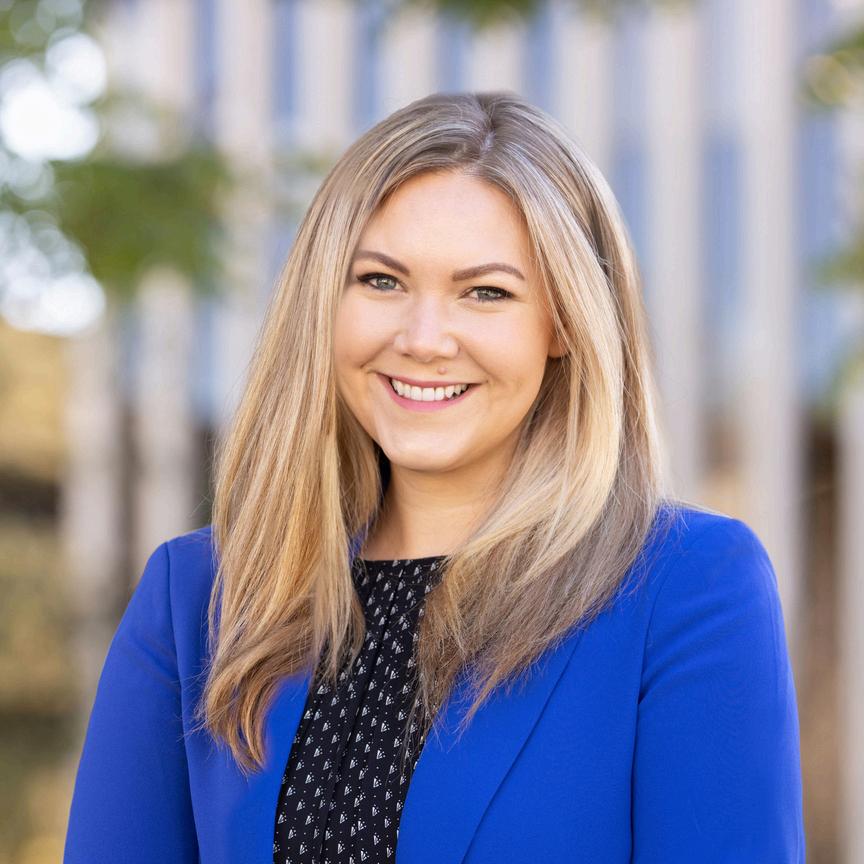
Emily Harrington is an Associate Attorney at Maier Law Group, an employment law firm in San Rafael Emily’s practice focuses on employment advice and counsel as well as serving as a neutral factfinder in workplace investigations. Emily advises employers on all aspects of California and federal employment law, including hiring, worker classifications, equal opportunity, anti-harassment, discrimination, and retaliation, wage and hour, leaves of absence, and employee separations Emily enjoys learning about organizational cultures, leadership styles, and behavioral skills

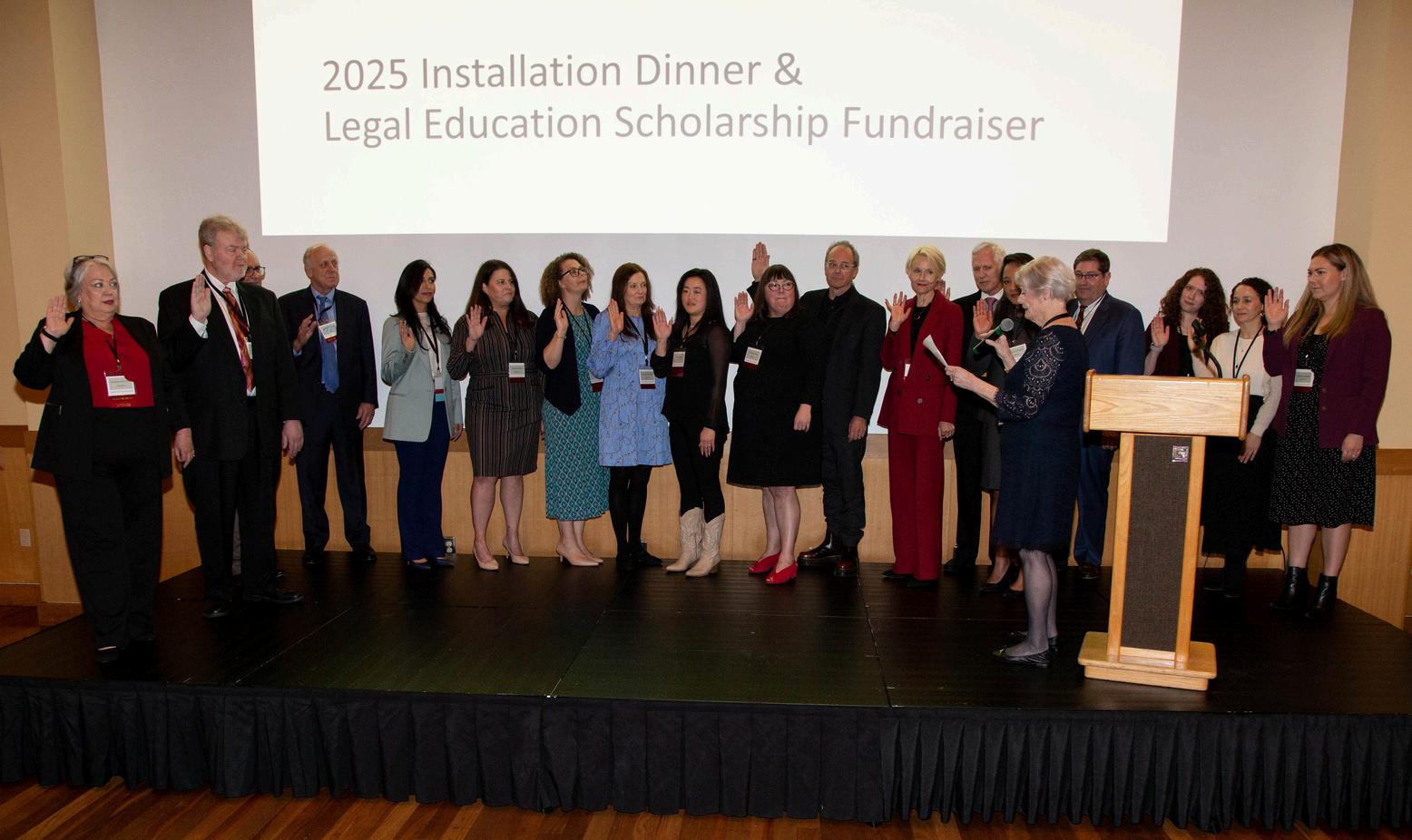
CONGRATULATION'S 2025 MCBA BOARD OF DIRECTORS & OFFICERS

Terence Carroll
In the coming years, sea level rise will have profound consequences for coastal West Marin. These consequences include threats to shoreline development, natural resources such as wetlands and other habitat areas, and public beaches, all of which support the economic, ecological, and social well-being of our coastal communities. Even now we see the beginnings of these impacts in the form of increasing incidence of flooding, shoreline erosion, and damage from storm surge.
The primary mechanism for adaptive response to these foreseeable impacts comes in the form of land use planning and regulation. To think about how this might work, let’s start with a simple model of land use regulation. County government creates geographical zones for residential, commercial, or industrial development, or other uses such as agriculture or open space Each zone has allowed and prohibited uses and also has developments standards such a height limits for buildings, and setbacks from property lines and sensitive habitat, for example. Each piece of land is assigned to zone, and then the county holds a public process to allow the public to respond to the proposal. Interest groups may advocate for changes or exceptions to the allowed uses and development standards. After the public process, the Board of Supervisors adopts the land use plan, and codifies the regulations by adopting an ordinance.


For coastal West Marin, we need to add some jurisdictional complexity to our simple model. The California Coastal Commission regulates development in the state’s coastal zone, which is, more or less, the area seaward of Highway 1. To facilitate local decision-making, the Coastal Commission delegates its authority to local jurisdictions through Local Coastal Programs, which must be certified by the Commission as consistent with the Coastal Act. In our simple model then, after the Board of Supervisors adopts the land use plan, it submits the plan to the Coastal Commission. The Commission can accept the plan, reject it, or suggest modifications that would make the plan consistent with Coastal Act. Any suggested modifications must in turn be approved by the Board of Supervisors.
Marin County’s Local Coastal Program was originally adopted in 1982. In 2019, the Coastal Commission certified a near-complete revision. The only section remaining from the 1982 Local Coastal Program is the Environmental Hazards section, which in part concerns development
standards related to flooding, shoreline and bluff erosion, groundwater intrusion, and storm surge, all of which will be exacerbated by sea level rise. In 2014, and again in 2016, the county submitted revised hazards policies to the Coastal Commission for certification. Both times, the Commission suggested modifications to make the policies Coastal Act-consistent, and both times the county withdrew its submission in response. As a result, development along Marin’s coast is regulated according to 1980s-era policies that don’t recognize or account for sea level rise.

several attempts to update its environmental hazards policies, to no avail. Recently, it started yet another such process, so it’s worth asking: Why is this so hard? Part of the answer can be found in our simple model of land use regulation. Two implicit assumptions underlie that model. The first is that the landscape is more or less fixed. Property lines don’t change, except by request of the landowner; public property is separate from private property; areas subject to hazards such as flooding are known, and can be mapped relatively precisely. The second implicit assumption is that all stakeholders agree on the meaning of terms used in the regulations. It’s clear to everyone whether a building exists or doesn’t; it’s obvious whether a building is new. These implicit assumptions fail when it comes to regulating an adaptive response to seal level rise in West Marin.
First, sea level rise makes the landscape fluid instead of static. In particular, the mean high tide represents the line between public trust and private lands, and as that line migrates inland due to rising seas, private property will begin to encroach on public tidelands. Second, in order to protect beaches and other coastal resources, the Coastal Act limits certain strategies that could be used to adapt to sea level rise. Foremost among these limits is a prohibition on shoreline armoring, such as seawalls and revetments, except in very narrowly-defined circumstances. Shoreline armoring is allowed, for instance, in order “to protect existing structures.” The Coastal Commission construes “existing” to mean existing at the time the Coastal Act came into effect in January 1977. Others, including in West Marin, construe it to mean “existing at the time a permit for coastal armoring is applied for,” which could include all structures existing now and in the future This issue has been litigated, and recently the Court of Appeal sided with the Coastal Commission (see Casa Mira Homeowners Assoc. v. California Coastal Commission, 107 Cal.App.5th 370 (2024) as modified by 327 Cal.Rptr.3d 906 (2024)). Another issue of contention is a Coastal Commission regulation that defines when repair and maintenance of an existing structure crosses over a line into the development of a new, “replacement structure” which may be subject to stricter regulations.
For over 10 years, these and similar disputes have carried on, paralyzing adaptation planning, all against the backdrop of rising water levels and increasingly powerful storms, with consequent shoreline erosion, property damage, and loss of valuable habitat for diverse species.
Unless Marin County can create coherent and equitable land use regulations guiding adaptation to sea level rise, West Marin residents will inevitably take matters into their own hands, including “asking forgiveness rather than permission.” But this ad hoc adaptation is a zerosum game. Your ad hoc sea wall will redirect flood waters into my home, forcing me to adapt to your adaptation, and so on in a chaotic daisy chain of development that serves no common
purpose. Those without the resources to respond will have their fates handed to them by their neighbors. Biodiverse coastal habitats will be washed away. This is hardly the future we would want for ourselves and our children, but time is of the essence if we want to avoid it.
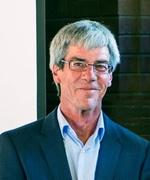
Terence Carroll is Co-founder and Research Director of River Otter Ecology Project (ROEP), a Marin-based conservation organization ROEP believes that lasting environmental change starts with local action Through research, advocacy, and community science, ROEP promotes the health of our
waterways ponds, rivers, creeks, lakes, and coastlines benefiting people, wildlife, and ecosystems River otter recovery in the San Francisco Bay Area and across the United States is the result of law and policy supporting wetland restoration and habitat conservation Sign up to receive our newsletter http://www riverotterecology org/ info@riverotterecology org



Carly Finkle, Senior Policy Manager & Diana Benitez, Senior Community Development Planner
Canal Alliance has been the leading advocate for low-income immigrants in Marin County since 1982. Focusing on education and immigration status to improve economic outcomes, we serve 4850 clients annually providing Immigration Legal Services, Youth and Adult Education, Workforce Development, and wraparound Social Services, including case management, health information, and a food pantry. Our mission is to break the generational cycle of poverty for low-income Latino immigrants and their families by lifting barriers to their success. To extend our impact and address systemic barriers, our advocacy and community engagement efforts support Latino community members to lift their voices and advance safety, opportunity and wellness in their community.
As part of the Marin Climate Justice Collaborative (Marin CJC), Canal Alliance officially launched the Nuestro Canal, Nuestro Futuro (NCNF) initiative to the public on October 19, 2024. This event, a vibrant community fair at Canal Alliance’s new headquarters at 711 Grand Avenue in San Rafael, highlighted the work the NCNF team along with the Consejo, our resident advisory committee, have done thus far.
While the Canal community in San Rafael faces climate change and climate injustices first hand, residents understand they must take more control of decisions about what investments and tradeoffs their community needs to ensure a safe and healthy future for their families. The Nuestro Canal, Nuestro Futuro initiative will bring in resident voices, ultimately developing a holistic Canal community’s vision for the future, imagining a Canal that is safe, healthy and affordable for everyone. As part of the Marin CJC, the NCNF initiative will build resident and organizational capacity and leadership in participatory planning, placemaking and community design. The NCNF team, along with the Consejo, the initiative’s resident advisory committee, will document this shared vision in a

Neighborhood Vision Plan. This Neighborhood Vision Plan will highlight the community’s strengths, needs and dreams, and will be used by Canal Alliance staff and the community to guide future neighborhood investments from government, philanthropists, and private businesses.

The Nuestro Canal, Nuestro Futuro launch party in October, was the first step on this journey, and brought together over 200 community members. Attendees were welcomed by Canal Alliance staff and then invited to visit various stations hosted by Canal Alliance departments, the City of San Rafael’s Sea Level Rise project, the Transportation Authority of Marin (TAM), Voces del Canal, Marin Transit, and Canal Arts. The booths served as a way to increase community awareness around the work and goals of these various projects, inviting the community to get involved in the processes. Attendees also enjoyed tacos, live music, raffles, and a kids’ coloring activity. To make the event as accessible as possible to Canal residents, Canal Alliance enlisted Vivalon to provide shuttles to and from


feedback, and staff worked together to gather input. Canal residents expressed appreciation for their neighbors in the Canal, organizations like Canal Alliance and the essential services we provide, Latino businesses who provide familiar
food and help send money and packages to Latin America, and access to nature via Pickleweed Park and the Bay Trail. Kids colored in line drawings of the Canal and shared their perspectives too, comments like, “My Canal is united, beautiful, home, pretty, and original.” The coloring pages were created based on images taken around the neighborhood, highlighting important spaces in the community such as recognizable local apartment buildings, Pickleweed Park and library, and street vendors.

Residents also acknowledged existing needs and gaps in the Canal as they took part in a placemaking exercise that invited them to reimagine that a local boating dock could become recreational and green space, a way to celebrate Latino culture with art, or affordable housing for Canal residents. If you would like to learn more about what residents shared at the fair, the full data analysis of the feedback received can be found here: Nuestro Canal, Nuestro Futuro, and here: TAM’s Bellam Blvd Engagement in the links provided.
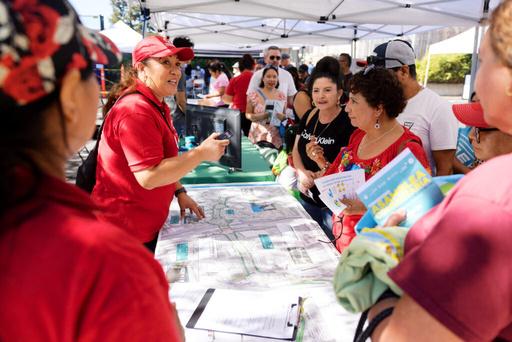
Looking to the future, this year Canal Alliance will identify one or two placemaking projects to pilot based on this first feedback session and future ones as well. Our next Community Fair will be held May 3rd and will be another opportunity for residents and community members to share ideas and dreams. (More details to come on this event in late February.)
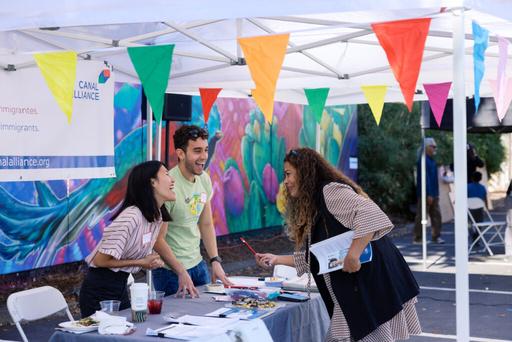
Nuestro Canal, Nuestro Futuro is a multi-year initiative to identify community priorities and work towards implementing them in the Canal. Text “nuestro” to (844) 508-1276 to participate. Stay informed by signing up for alerts and notifications. Receive updates on community events, workshops, and important announcements related to the Neighborhood Vision Plan.

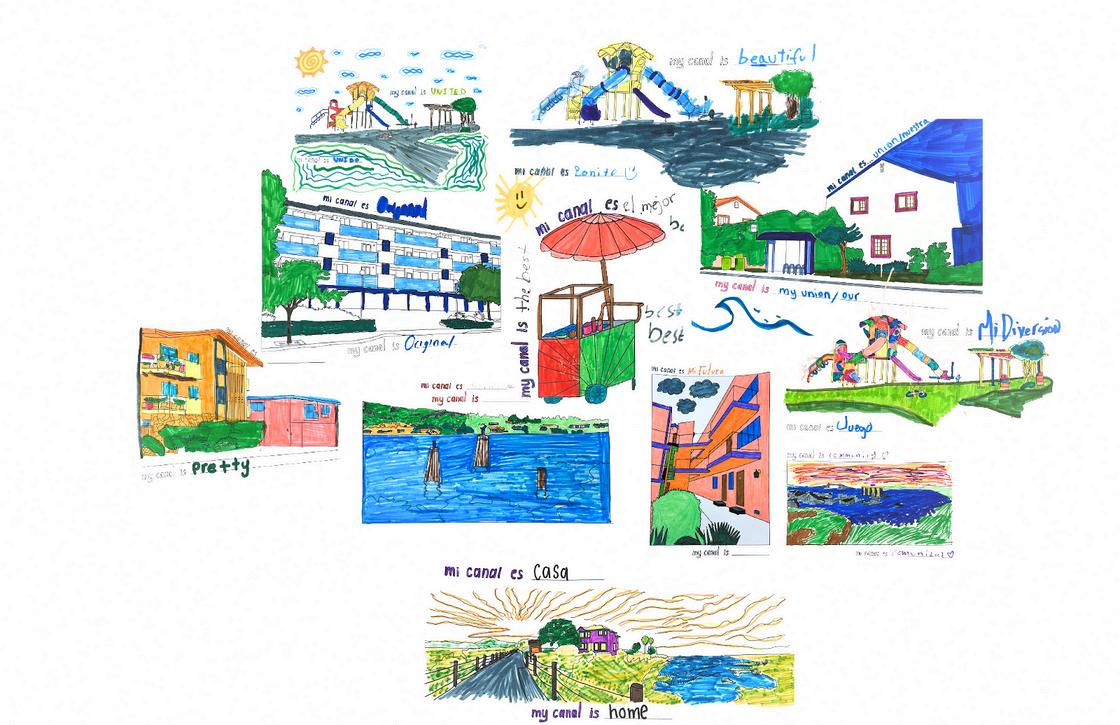
MCBA LEADERSHIP CIRCLE MCBA LEADERSHIP CIRCLE

Scott Buell Scott Buell
Buell Law & Mediation
Buell Law & Mediation
Peter Kleinbrodt
Peter Kleinbrodt
Freitas Law Firm
Freitas Law Firm
Niran Somasundaram, Senior Counsel - Hanson Bridgett LLP
The California Environmental Quality Act ("CEQA") has long been a cornerstone of environmental oversight in the state, but its rigorous environmental review process often poses an obstacle to housing projects leading to potentially lengthy delays, increased project costs, and potential legal challenges.
In recent years, the California Legislature has explored the use of CEQA exemptions and streamlining to help ease potential obstacles to much- needed housing projects. Recent bills allow certain projects – especially those that meet certain priority criteria, such as affordable housing, infill development, or developments near housing – to avoid extensive environmental review processes, expediting approval and construction.
In the 2024 Legislative Session, lawmakers extended and modified several CEQA exemption or streamlining pathways for housing projects that had been established in prior years. Below is an overview of the most relevant CEQA bills which took effect on January 1, 2025, and how they may impact projects going forward.
Prior to AB 1633 CEQA
AB 1413 clarifies provisions of the landmark AB 1633 which went into effect last year and extends the protections of the Housing Accountability Act ("HAA") to impose penalties on local governments that fail to comply with certain timelines for CEQA determinations or make appropriate CEQA exemptions, negative declaration or addendum determinations for infill housing projects. For more information on AB 1633, please see Hanson Bridgett's previous alert on the topic.

AB 1413 keeps AB 1633's tight CEQA determination deadlines while clarifying the level of public notice that a city and county must provide before making any CEQA determination for an eligible infill housing project. Under AB 1413, after a project applicant has provided an agency with written notice about a project's eligibility for a CEQA exemption, negative declaration or addendum, the local agency is required to post said notice on its website, file it with the county clerk within five working days and provide copies to certain individuals as required under CEQA. AB 1413 further mandates a minimum public review and comment period of 60 days following receipt of the applicant's notice, and requires that the agency consider any objections, comments, evidence, or concerns received during said period before issuing a final written response to the project applicant's notice The public comment period notwithstanding, the local agency must still comply with the 90- or 180-day final written response deadline imposed by AB 1633.
By clarifying the public review required prior to AB 1633 determinations, while maintaining the strict timelines imposed on local agencies, AB 1413 provides clearer guidelines for local agencies, benefiting developers by improving predictability and transparency of the approval process.
for Homeless Shelters and Tiny Home Low Barrier Navigation Centers
SB 1395 aims to support housing and services for individuals experiencing homelessness by expanding the applicability of Government Code section 65662, which mandates by right approval, with no CEQA review, of the proposed development of Low Barrier Navigation Centers (low barrier, service-enriched temporary shelters focused on moving people into permanent housing) in mixed-use zones and non-residential zones that permit multi-family uses SB 1395 specifically expands the definition of Low Barrier Navigation Centers to include centers composed of relocatable, single-room housing, often colloquially referred to as "tiny homes."
SB 1395 also expands CEQA exemptions for local agency actions supporting homeless shelters and Low Barrier Navigation Centers from 2026 until 2036. This bill not only continues to exempt the leasing of government land for such projects from CEQA's cumbersome environmental review process, but also broadens the exemption to include local agency actions to approve service contracts associated with these
shelters, otherwise financially support such projects, or construct certain projects themselves. This change enables cities and counties to expedite support services as well as the physical structures of these facilities.
For developers and local agencies working on homelessness and transitional housing, SB 1395 significantly reduces the regulatory hurdles, creating a more straightforward pathway for projects aimed at serving the state's most vulnerable populations.
AB 2199 extends the CEQA infill exemption for residential and mixed-use housing projects located in unincorporated county areas of California, set to expire in 2025, until 2032. Under the pre-existing exemption, qualifying multifamily housing developments of six or more units in rural or unincorporated county areas are exempt from CEQA, provided they meet certain requirements such as general plan consistency, density requirements, proximity to existing qualified urban uses, and less than significant impacts relating to transportation, noise, air quality, greenhouse gas emissions, or water quality. While the exemption extension makes it easier for developers to build certain projects in these areas, the bill also adds a new criterion for qualification: the project may not cause a substantial adverse impact to Tribal cultural resources.


SB 312 extends, until January 1, 2032, a preexisting CEQA exemption for certain Leadership in Energy and Environmental Design (LEED) Platinum-certified student or faculty housing developments undertaken by public universities (or developers partnering with public universities) on public university property near university campuses or public transit. Qualifying projects must also demonstrate that they would not result in a net additional emission of greenhouse gases through a combination of project features and emission offset credits. SB 312 allows for increased flexibility on LEED certification timelines, but includes increased limitations on project siting for University of California projects.
The bill adjusts the timing requirement for projects utilizing the exemption to obtain LEED Platinum certification. Under prior iterations of the law, LEED certification had to be obtained before an occupancy permit for the building was issued. SB 312 allows universities up to 18 months after a building's occupancy to obtain this certification. Additionally, universities may request two six-month extensions if they are unable to meet certification requirements within the initial timeframe. However, the bill includes a key limitation: a university cannot apply the CEQA exemption to new housing projects until it has achieved LEED Platinum certification for all constructed buildings in any prior exempted project.
The bill also limits the use of the exemption for University of California projects to only those projects located on a campus site identified for housing in the most recent long-range development plan environmental impact report (EIR).
These new bills introduce important pathways for developers seeking to navigate California's complex regulatory environment more efficiently. By taking advantage of the exemptions and streamlined process offered by these bills, developers can potentially save time and reduce costs on eligible projects. However, the specific criteria and conditions attached to each bill mean that compliance can still be nuanced. If you have any questions about how these changes might impact your projects or need guidance on navigating CEQA requirements, please reach out to our team.

iran Somasundaram focuses his practice n land use and environmental matters He equently advises landowners, developers nd public agency clients in land use land use nd environmental regulatory matters and has xperience conducting land use due diligence, reparing and processing entitlement
pp , ring compliance with the California Environmental Quality Act (CEQA) and other land use and environmental legislation, and representing clients in administrative proceedings in front of federal, regional and state agencies, including regional and the state water board, state environmental agencies, and the Environmental Protection Agency
WELL-BEING
Wednesday, March 26th
1.0 Competence CLE
Join the Wellness Panel as they take an indepth look at Mental Health & Attorneys and the practical tools available to support emotional fitness and resilience.
Tuesday, April 22nd
1.0 Gen CLE
Avoiding Top Errors in Retirement Settlements--Tracking Market Gains and Equalization
Thursday, April 3rd
No RSVP, No-Host, No Fuss just show up, buy yourself a drink and an appetizer, and enjoy casual, face-to-face conversations with fellow attorneys who work or live in Marin County.
Sunday, April 27th
9:00 AM - 11:00 AM
Let’s celebrate Earth Day together by joining Marin County Parks for a park beautification workday.

Lucie Hollingsworth
We’re trying something new in the MCBA newsletter. While we often spotlight a Marin judge, we thought we would start asking those questions that we really ponder as we wait for our case to be called - who is the person really behind the intimidating robe perched high above?
With this in mind, we thought it fitting to start off with Judge Andrew Sweet. Appointed to the bench in 2009, Judge Sweet currently supervises Marin’s civil division. What makes Judge Sweet special is his ability to reduce the anxiety of litigants by humanizing himself and the process. Judge Sweet introduces himself as “Andy” during UD mandatory settlement conferences. He also has stepped down from his bench during a contentious hearing to take a seat in front of a particularly stressed litigant to just have a conversation (without attorneys getting in the way). His approach works to break through the emotions and obstacles that a courtroom can inspire, and often leads to a seemingly elusive settlement. As one litigant noted, “I’ve never felt heard before and I didn’t expect that coming from a judge.” A lesson for us all? Probably. But we’re not here to pontificate. Judge Sweet’s demeanor on the bench makes us want to learn more. So without further adieu, the answers to the questions we are all dying to know!

Hon. Andrew Sweet
What book did you take on your last vacation?
“The question calls for a book I took, not one I read. I took two books - Slow Horses by Mick Herron and Daughters of Shandong by Eve Chung.
I made good progress on Slow Horses but I did not get to Daughters of Shando Trust that I will though because the latter is the subject of our first ever extended family book club that meets a the end of February.”
What is your favorite phone app?
“What’s a phone app?”
If the TV is on, what s makes you stop and watch?


“Any basketball game where Steph Curry is playing.”
If you could invite someone from history to dinner, who would it be?
“I think my paternal grandfather Hy Sweet. I barely knew him before he passed away. I would relish the opportunity to hear details about his life and his perspective on my father’s life as a young person. ”
[BONUS] Rumor is that you like the Grateful Dead. What’s your favorite Dead song? What was your favorite Dead show?
“My favorite song is probably Ripple. My favorite Dead show was definitely New Year’s Eve 1986 at Henry J. Kaiser. That’s all I will say!”
Platinum Sponsor










Interested in Sponsorship? Contact Julie Cervetto
Sean Herman, Christopher Powell & Alexander Ames, Hanson Bridgett LLP
In a significant milestone for carbon capture and sequestration (“CCS”) projects in California, the Environmental Protection Agency (“EPA”) issued four Class VI Underground Injection Control (“UIC”) permits in the Biden Administration’s final days. These permits are the first Class VI injection wells that the EPA has approved in California.
As CCS projects gain momentum, developers must navigate a multi-layered permitting process that involves federal, state, and local agencies. Projects typically require Class VI UIC permits, alongside other environmental and land-use approvals, to ensure compliance with CO2 storage regulations, water quality standards, and habitat protections. Federal and state funding, including grants from the Department of Energy’s Office of Fossil Energy and Carbon Management, further supports CCS development, with recent California legislation expanding tax-exempt financing options for qualifying projects. These regulatory and financial frameworks aim to facilitate the deployment of large-scale CCS initiatives while maintaining rigorous environmental oversite With these factors in mind, the EPA’s recent Class VI UIC permits mark a crucial step in advancing CCS infrastructure and clarifying federal compliance expectations.
Under the Safe Drinking Water Act, the EPA regulates wells that inject fluids underground for storage through Class VI permits. The Class VI UIC permits recently issued by the EPA authorize constructing four deep injection wells that will safely inject and store CO2 into deep geologic formations. These injections can significantly reduce industrial emissions by capturing emissions at the point source. The EPA determined that the regional and local geologic features of the well locations allow for safely storing nearly 38 million metric tons of CO2, thus protecting underground sources of drinking water These determinations follow a thorough technical review of the project proponent’s supporting data and review of thousands of public comments on the draft permits.

The UIC permits require that project proponents adopt rigorous monitoring protocols, including continuous measurement of CO2 levels, ground water quality checks, well integrity monitoring, and transparent public reporting. The project proponents also must plug 200 wells in the area where CO2 is expected to migrate during the project before carbon injections begin.

These permits underscore ongoing efforts to combat climate change by promoting CCS. First of their kind, these permits provide a federal regulatory framework for CO2 storage. These permits should facilitate the expansion of CCS infrastructure throughout California.
But these developments are not without controversy. In November 2024, community groups sued Kern County over its approval of a CCS project. The lawsuit claims the County failed to adequately assess environmental risks, including potential air quality impacts, groundwater contamination, and local ecological disruption. The lawsuit reflects uncertainty over the role of CCS in the transition to renewable energy. Concerns include the diversion of resources away from clean energy solutions and the continued reliance on fossil fuel-based systems. These debates highlight the complexities of CCS adoption as a climate mitigation strategy.
While substantial shifts in policies from the incoming Trump Administration are forthcoming, we can expect continued bipartisan support for CCS technologies and permitting. The economic and environmental potential of CCS drives this support. The Trump Administration, for example, has expressed interest in streamlining CCS permitting processes through state involvement. In October 2024, the Carbon Capture Coalition encouraged President Trump’s election campaign to advocate for streamlined permitting processes and federal support for CCS infrastructure. The Coalition cited bipartisan backing and the economic benefits of expanded carbon management technologies.
By granting the Class VI permits, the Biden Administration aligned itself with the streamlined permitting process that the Coalition encourages These permits also reflect the federal and California state government’s’ shared commitment to advancing cutting-edge CCS technologies while upholding rigorous environmental and safety standards. There are many overlapping permitting requirements, which can be challenging. So this shared commitment is critical to mitigating the harm that climate change presents.



Sean G. Herman advises and litigates on behalf of clients in natural resource and land use matters His clients include public agencies as well as commercial developers, agricultural companies, etc
Chris Powell helps clients develop and use their properties for commercial/residential development, mining and oil & gas resource extraction, and mitigation banking and conservation easement projects.
Alexander Ames helps clients with real property transactions and land use agreements, focusing on environmental issues pertinent to mining and mitigation banking


Katharine Berg
Rally Family Visitation Services has been making big and small changes over the past year to strengthen Rally's work supporting safe and healthy kids, parents, and family systems in Marin County and across the Bay Area. They provided over 1,300 visits and exchanges last year to 339 children and adults. Rally serves kids and families navigating concerns in Family Court related to child abuse, child abduction, domestic violence, substance use, mental health and other parent behavioral issues providing Visitation Center-based professional services in Marin, San Francisco, and San Mateo Counties.
Children have the right to be safe and free from abuse Research also links the absence of parental contact with a wide range of negative health and life outcomes. This delicate intersection makes Rally’s work and their laser focus on safety essential.
So what’s new?
In October 2024, Rally re-opened access to their Marin County in-person visitation and exchange services, dormant since 2020.
In April 2024, Katharine Berg came onboard to steer Rally into its next chapter, after longtime director Sonia Melara retired. Ms. Berg brings two decades of experience in frontline Bay Area social services replacing cycles of violence and vulnerability with hope, joy and equitable access to critical resources.
Early next year, our San Mateo Visitation Center will relocate to an upgraded facility. Stay tuned for more details.
In between, the acquisition of Rally’s longtime home and source of cornerstone support, now UCSF Health Saint Francis Hospital, on August 1, 2024 was a critical milestone, opening the door to a new era of leverage and opportunity.
These milestones, and Rally’s achievements over the past year keeping kids safe, parents safe, and kids and parents connected through 1,300 safe visits and exchanges spring from their partnerships, advocacy, and contributions. Without Rally’s services, the alternatives are few and often unsafe for children and/or adults. So, thank you!
To celebrate 34 years of ensuring the safety of high-risk and low-income families, please join Rally Family Visitation Services on April 24, 2025 for its annual fundraiser: Through the Eyes of Children The event will take place at UC Hastings from 5:30 PM–8:30 PM. Corporate or individual sponsorships are available now from $500 to $2,500. Email katharine.berg@ucsf.edu to make a commitment to find out more.

Katharine Berg is a dedicated activist and advocate for social justice, currently serving as the Executive Director at Rally Family Visitation Services With a career focused on integrated health and community-rooted antiviolence strategies, she has worked to address and eliminate systemic inequities
Prior to her current role, Katharine was the Director of Community Partnerships and Philanthropy at La Casa de las Madres, where she fostered collaborations to support individuals affected by domestic violence

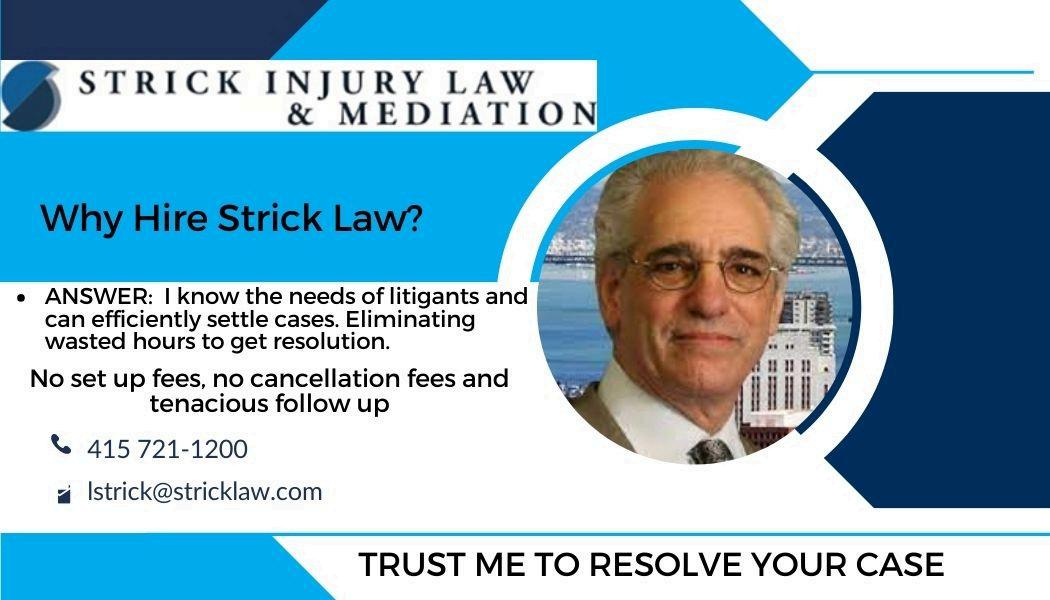
Marin County Bar Association
Here is Shanti Eagle, in her own words.
Tell us about your professional practice (i.e., where do you work, what do you focus on, what’s your ideal or typical case/matter)?
I am a Partner at Farella, Braun + Martel, LLP, in San Francisco, and my practice is dedicated to Insurance Recovery. That means that I advocate exclusively for policyholders in complex insurance coverage disputes. I love this area of the law because we are involved in all kinds of cases, both in and pre-litigation, helping problem solve and achieve resolution while maximizing the value of the insurance. I deal with coverage for everything from construction defects, to employment claims, to consumer class actions, to white collar investigations that make national headlines. I also get to be involved in a lot of cutting edge issues, like privacy regulation enforcement actions and AI generation, as there is always a period of uncertainty while the insurance industry adapts to new statutes and types of claims.
Tell us about yourself, personally (i.e., where are you from, where do you live now, what do you do for fun, etc.)?
I grew up in Santa Cruz, but my mom ’ s family is from Marin and I spent many summers and holidays with my grandparents in Lucas Valley, so it has always felt like a second home. When I graduated law school, I knew I wanted to move here and put down roots. We’ve been living in Marin for nearly 15 years now, and in Sausalito for the last 10.
What inspired you to join the MCBA Board of Directors?
I wanted to reconnect with the legal community in Marin. After going back to work in the City and then the pandemic shortly thereafter, I was missing the
community connection. I also wanted to get more involved and give back here, in our community. It has been very rewarding to be a part of the scholarship committee, and be able to support the academic journey of some amazing and inspirational Marin high school graduates, some of whom are now practicing attorneys.

What is your favorite weekend activity in Marin?
I like to hike and go to the beach, but most of the time you’ll find me on the sidelines at my kids soccer games.
What book have you read in the past 12 months that you enjoyed?
Project Hail Mary by Andy Weir was a delightful surprise. I listened to it on audiobook, and I highly recommend it. I also enjoyed A Man Called Ove (Fredrik Backman).
Favorite restaurant(s) in Marin?
Samurai Sushi in Mill Valley, Sol Food (always), and Arawan Thai in Sausalito are some of our go-tos.
Liat D. Blum
Blum Trusts & Estates
Andre Walker Brewster III
Marin County Public Defender's Office
Liliana N. Carbone
Brayton Purcell LLP
Maria A. Caruana
Molly Cohen Phipps
Tracey B. Cowan
Thomas Andrew Davies
A. Davies Personal Injury Law
Keren Schlank Freeberg
Marin County District Attorney's Office
Harvey Gee
Marin County Public Defender's Office
Rebecca L. Gindi
Marin County Public Defender's Office

ADR
Barristers
Business
Construction
Criminal
Diversity
Employment Labor
Estate Planning
Probate
Morgan E. Hansen
Thompson, Welch, Soroko & Gilbert LLP
Ashley L. Johnson
Marin County Public Defender's Office
Julian Kunik
Brayton Purcell LLP
Kevin N. LaBarbera
Marin County District Attorney's Office
Vicki Nugent Lindquist
Laughlin, Falbo, Levy & Moresi
Karla Madrazo Villarreal
Brayton Purcell LLP
David Mishook
Max Moyer
Gabriela Munoz-Gomez
Brayton Purcell LLP
Mike Osterman
Mentoring Grp
Family Law
Intellectual Property Litigation
Probate Litigation
Real Property Tax
Roger Peters
Justin M. Proctor
Brayton Purcell LLP
Daniel Riviera
Riviera Law and Mediation
Alyssa B. Samuel Husch Blackwell LLP
Barry Schneider SchneiderLaw
Diane L. Shappy
Brandon Donald Smith Scherer Smith & Kenny LLP
Katie Sullens
Signature Resolution
Christopher Jason Wong
Marin County District Attorney's Office
Michael Young
If you are a current 2025 MCBA member, you can use the listserv to query your colleagues on legal updates, ask for recommendations for experts, share Court administrative processes, and use the platform to expand legal knowledge. To maintain engagement and sign-ups, we don't use the listserv for advertising, campaigning, or for public discourse To join the listserv Sign Up HERE Start using the listserv and email your message to current subscribed MCBA Members at mcba@groupvine.com or send to these specific practice

THERE ARE MANY EXCELLENT REASONS TO BECOME A MEMBER OF MCBA! HERE ARE JUST A FEW:
Build relationships with fellow attorneys and other professionals.
In collaboration with our sections, we offer many CLE programs, covering topical and timely issues.
MCBA, with The Marin County Law Library, offers free legal consultations through our Lawyers in the Library program.
MCBA supports financially disadvantaged students pursuing a law school degree and all high schools participating in Mock Trial.
MCBA’s website and monthly Marin Lawyer newsletter deliver updates on events, court notices, timely legal articles, and legal community news.
MCBA membership provides access to an exclusive community of attorneys and other legal professionals. Explore your leadership potential through board and committee involvement.
Renewal is even easier with our auto-renewal service.
Special offers from select partners.


Kristine Fowler Cirby
President
Cirby Family Law Offices



Neusha Ghaedi
Treasurer
DeMartini, Walker, & Ghaedi LLP


Scott Buell
Past President
Buell Law and Mediation

Julie Cervetto

Thomas M. McInerney
President-Elect
Ogletree Deakins
Robyn B. Christo
Secretary
Epstein Holtzapple Christo LLP
Matt White
5-Year Past President
Monty White LLP
David M. Zeff
Client Relations Chair
Law Offices of David M. Zeff







Elisha J Yang 2025 Director Hanson Bridgett LLP
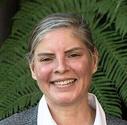
Morgan H. Daly 2025 Director Law Office of Morgan Daly
Lucie C Hollingsworth 2025 Director Legal Aid of Marin

Nestor Schnasse 2025 Director Schnasse Law

Ingrid L Carbone 2026 Director Carbone Family Law
Roni D. Pomerantz 2026 Director California Department of Justice



Shanti Eagle 2025 Director Farella Braun + Martel LLP
Marrianne S Taleghani 2026 Director Nixon Peabody LLP


R. Wesley Pratt 2027 Director County of Marin

Emily Harrington 2027 Director Maier Law Group

Sarah Anker 2027 Director County of Marin
Christine O‘Hanlon 2026 Director County of Marin
Marisa R. Chaves 2026 Director Hanson Crawford Crum
Adrea Tencer 2027 Director ADZ Law, LLP
Paul Burglin 2027 Director Burglin Law Office, P C
To involve, encourage, and support Bar Association members, to serve as a liaison to the Marin County Courts, to educate the community and enhance access to legal services.

